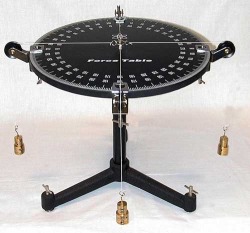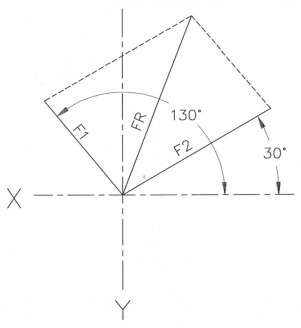Elise Livingston
Force Table Lab
Purpose:
The purpose of this lab was to gain experience in working with vector quantities. The lab involved the demonstration of the process of the addition of several vectors to form a resultant vector. Graphical solutions for the addition of vectors was carried out, as well.
The purpose of this lab was to gain experience in working with vector quantities. The lab involved the demonstration of the process of the addition of several vectors to form a resultant vector. Graphical solutions for the addition of vectors was carried out, as well.
Equipment:
- Force table with pulleys, ring, and string
- Metric ruler, protractor, graph paper
- Force table with pulleys, ring, and string
- Metric ruler, protractor, graph paper
Data / Analysis:
TABLE 1
Force Mass (kg) Force (N) Direction
F1 0.25 2.4525 130*
F2 0.35 3.4335 30*
Equilibrant FE 0.4 3.924 249*
Resultant FR 0.4 3.924 69*
TABLE 2: Graphical Solution
Force Mass (kg) Force (N) Direction
F1 0.25 2.4525 130*
F2 0.35 3.4335 30*
Resultant FR 0.4 3.85 69*
TABLE 3: Analytical Solution
Force Mass (kg) Force (N) Direction X Component Y Component
F1 0.25 2.4525 130* -1.5764 1.8787
F2 0.35 3.4335 30* 2.9734 1.7167
Resultant FR 0.4 3.8572 68.766* 1.397 3.5954
Calculations:
I calculated the components of the vectors by using the F*cos(theta) for the x components and using F*sin(theta) for the y components. Therefore, the x component for the vector at 30 degrees was calculated as 3.4335*cos(30) and the y was calculated as 3.4335*sin(30) while the other component was computed with the x component as 2.4525*cos(130) and the y component as 2.4525*sin(130).
Error Calculation:
Percent Error Magnitude Experimental Compared to Analytical: (3.924-3.8572)/3.8572 x 100= 1.7318 %
Percent Error Magnitude Graphical compared to Analytical: (3.85-3.8572)/3.8572 x 100= -.1866%
TABLE 1
Force Mass (kg) Force (N) Direction
F1 0.25 2.4525 130*
F2 0.35 3.4335 30*
Equilibrant FE 0.4 3.924 249*
Resultant FR 0.4 3.924 69*
TABLE 2: Graphical Solution
Force Mass (kg) Force (N) Direction
F1 0.25 2.4525 130*
F2 0.35 3.4335 30*
Resultant FR 0.4 3.85 69*
TABLE 3: Analytical Solution
Force Mass (kg) Force (N) Direction X Component Y Component
F1 0.25 2.4525 130* -1.5764 1.8787
F2 0.35 3.4335 30* 2.9734 1.7167
Resultant FR 0.4 3.8572 68.766* 1.397 3.5954
Calculations:
I calculated the components of the vectors by using the F*cos(theta) for the x components and using F*sin(theta) for the y components. Therefore, the x component for the vector at 30 degrees was calculated as 3.4335*cos(30) and the y was calculated as 3.4335*sin(30) while the other component was computed with the x component as 2.4525*cos(130) and the y component as 2.4525*sin(130).
Error Calculation:
Percent Error Magnitude Experimental Compared to Analytical: (3.924-3.8572)/3.8572 x 100= 1.7318 %
Percent Error Magnitude Graphical compared to Analytical: (3.85-3.8572)/3.8572 x 100= -.1866%
Analysis Questions:
1. Possible sources of errors include 1) friction in the pulleys, 2) the fact that we ignored the mass of the strings, and 3) errors in direction of the forces if the strings were not at 90 degrees to the a tangent to the ring. Rank the relative importance of these errors in your data.
I think that the most important factor in this list would be the errors in direction of the forces if the strings were not at 90 degrees to the tangent. This is very important because, if this angle is off, all of the other angles in the experiment would be different and it would change the entire experiment. I feel that the second most important factor would be the fact that we ignored the mass of the strings. This is important because it throws off the real numbers for equilibrium. We found the equilibrium minus the mass of the strings which could have led to some error, especially if the strings were different and, therefore, had a different mass value. The final factor regarding friction in the pulleys is still important. Friction is another force, and it too, has to balance out to create true equilibrium. However, I feel that the other two factors had a more direct impact on the actual experiment.
2. If pulleys were not used, would the errors have gone up? Why?
I think that they would. Without pulleys, it may have been much more difficult to set up the correct angles and to make the conditions of each string and weights identical. Without this uniformity, the whole experiment would have turned up different numbers due to error.
1. Possible sources of errors include 1) friction in the pulleys, 2) the fact that we ignored the mass of the strings, and 3) errors in direction of the forces if the strings were not at 90 degrees to the a tangent to the ring. Rank the relative importance of these errors in your data.
2. If pulleys were not used, would the errors have gone up? Why?


